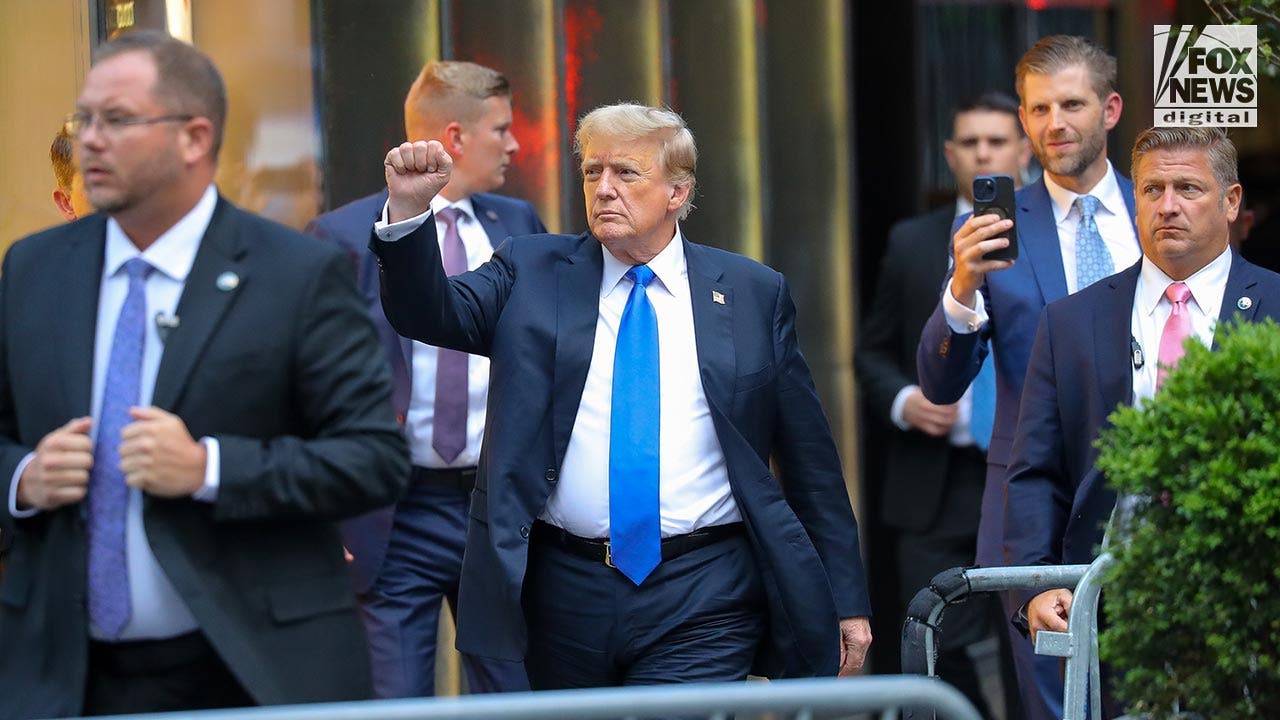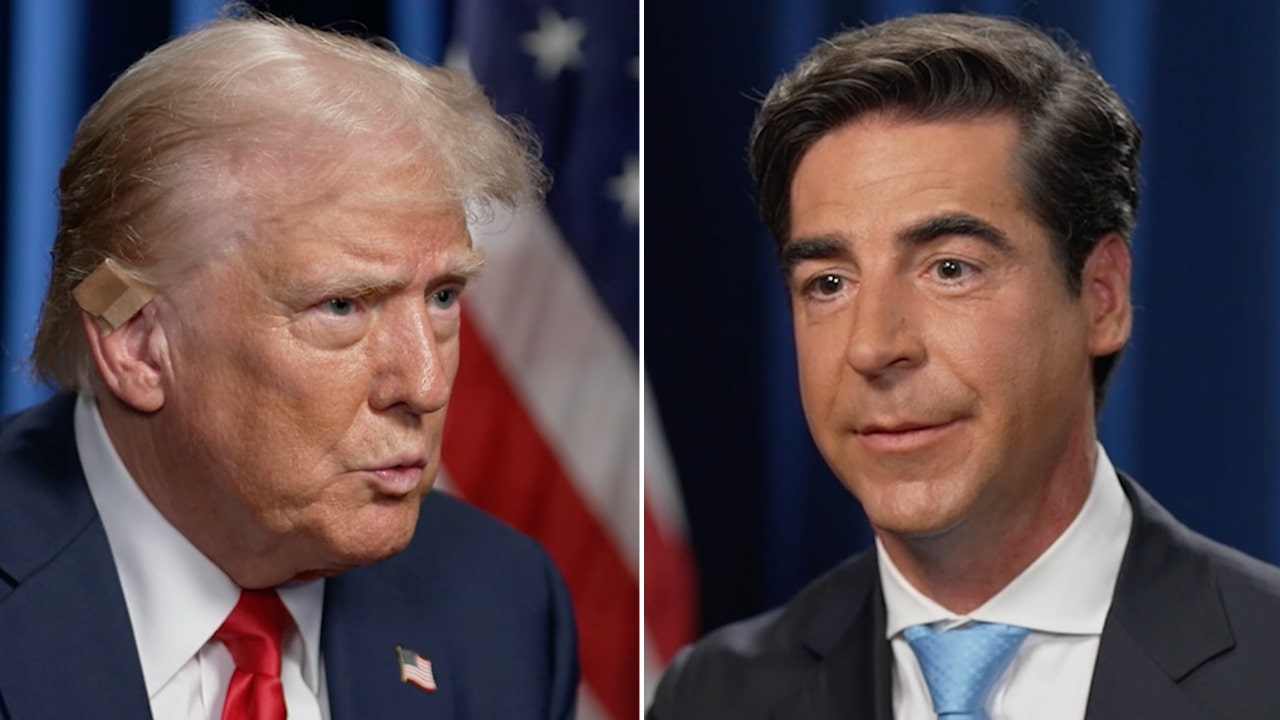World
Populists shut out of European political systems that favor establishment parties
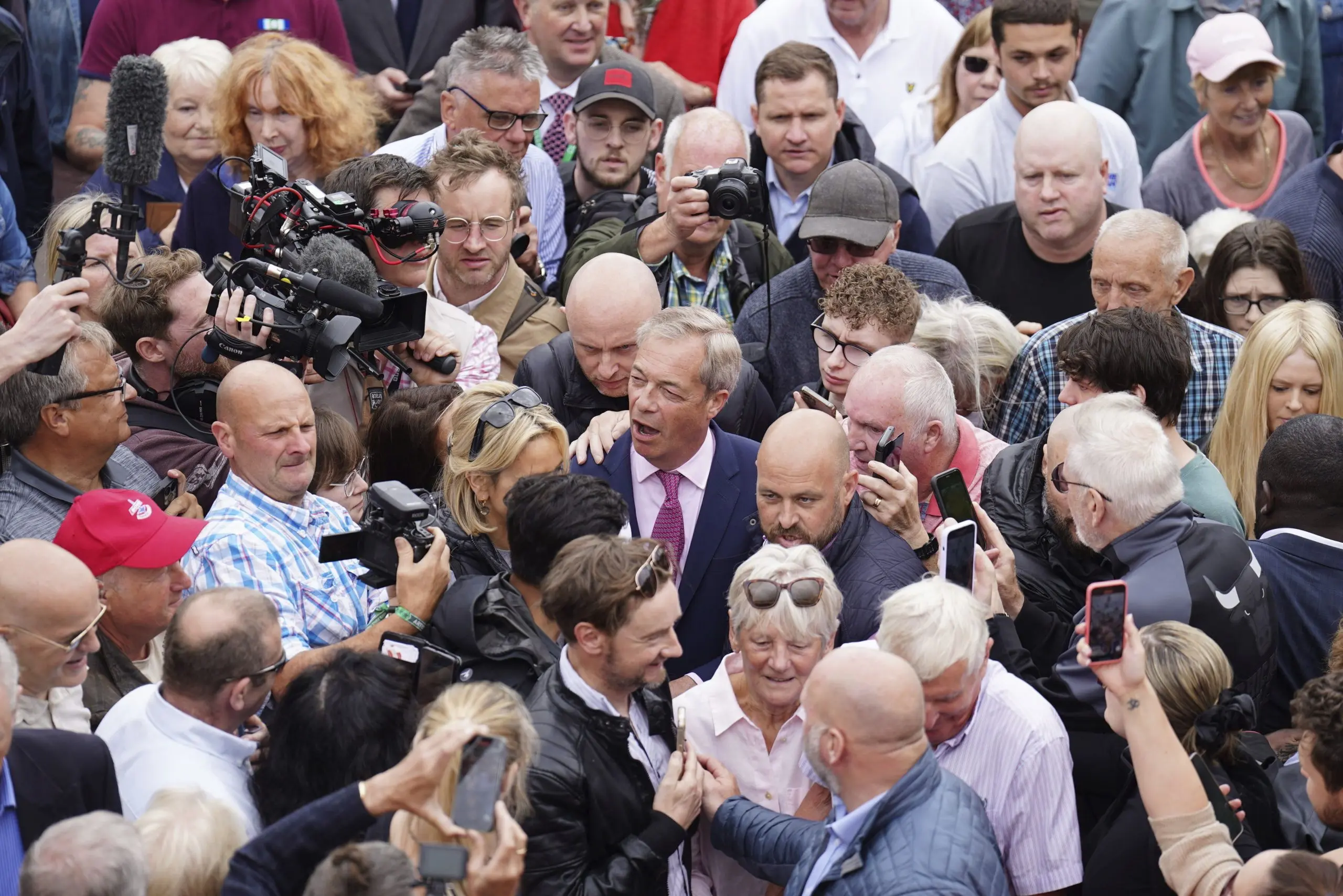
LONDON – Voters abandoned mainstream center-right parties for the populist right in the U.K. and French elections this month but failed to convert support to electoral gains amid a right-wing vote split and tactical voting by the left.
Britain’s Labour Party, led by Keir Starmer, won a landslide election victory, scoring 412 seats in the 650-seat Parliament, eclipsing the mainstream Conservative Party that managed to hold on to just 121 seats after losing 244 seats.
This was the worst performance in the Conservatives’ nearly two-century history amid the surge of upstart populist Reform Party, led by ‘British Trump’ Nigel Farage, that received over four million votes but gained only five seats.
NIGEL FARAGE SHAKES UP UK ELECTION, ESTABLISHMENT ON RETURN TO POLITICS: ‘BRITISH TRUMP’
Nigel Farage, Leader of Reform UK and local candidate Mark Butcher watch the Denmark v. England UEFA EURO 2024 game at the Armfield club on June 20, 2024, in Blackpool, England. (Photo by Christopher Furlong/Getty Images) (Christopher Furlong/Getty Images)
In France, a broad leftist coalition consisting of hardline communists, environmentalists and socialists won 188 out of 577 seats in the parliament, seconded by French President Emmanuel Macron’s centrist alliance Ensemble (ENS), which won 161 seats, forming a ruling majority.
France’s populist National Rally, led by Marine Le Pen, won over 37% of the vote and was the single most popular party among French voters, yet it came third in the number of parliament seats. The mainstream center-right Republicans came a distant fourth, with just 6.2% of the vote.
“What was quite clear was that this was a rejection of the Conservative Party, the mainstream Conservative party,” Alan Mendoza, the executive director of the London-based Henry Jackson Society, told Fox News Digital. “In France, they got a very high turnout for France, and in that case, it was clear that this was an anti-National Rally election.”

Marine Le Pen, President of the National Rally group in the National Assembly, joins Jordan Bardella, President of the National Rally (Rassemblement National), at the final rally before the recently held European Parliament election on June 9th, (Photo by Artur Widak/NurPhoto via Getty Images) (Artur Widak/NurPhoto via Getty Images)
The elections demonstrated the voters’ persistent support for political movements embracing right-wing populism on issues related to immigration, crime and social issues while abandoning milquetoast traditional center-right parties for failing to bring meaningful change.
Yet, the insurgent populists came up short of converting the widespread support at the voting booth to electoral gains due to tactical voting agreements and support split among right-leaning voters.
FRENCH ELECTIONS: RIOTS ERUPT AFTER LEFT-WING COALITION PROJECTED TO WIN PLURALITY OF SEATS
“In both cases, the left-wing parties were able to maximize their votes, and the right-wing parties were not able to maximize their votes,” Mendoza said. “It’s been said that Labour’s support is a mile wide and an inch deep, but that’s what you need to win British elections with large numbers of support without being focused in certain areas,” Mendoza added about Labour’s lower overall popular support.
“The reality in France was that various left-wing parties and Macron got together and basically shut the right out, but the right did not do a similar thing. The Republicans stayed in the race and did not give way to the National Rally or vice versa.”
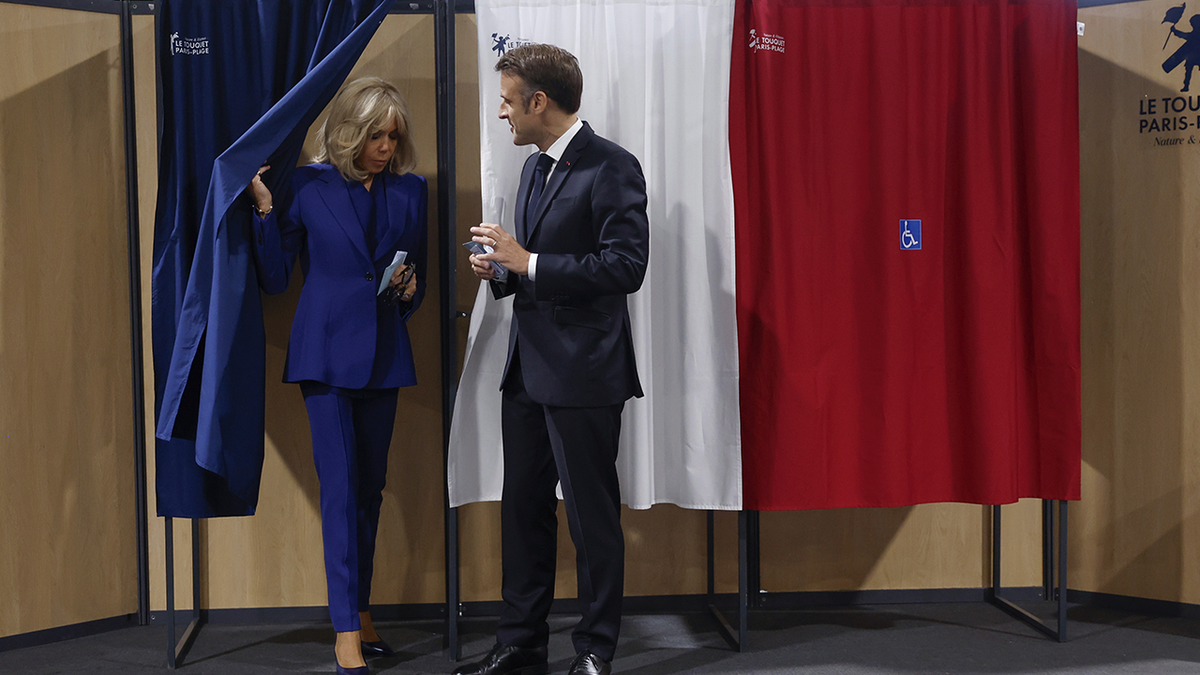
French President Emmanuel Macron and his wife Brigitte Macron leave the voting booth before voting for the second round of the legislative elections in Le Touquet-Paris-Plage, northern France, Sunday, July 7, 2024. (AP)
Le Pen’s National Rally came out on top in the first round of voting last month after campaigning on significantly reducing immigration and crime and improving the economy.
The populist party was on the cusp of winning the majority of seats in the second round, but the effort was curtailed after a tactical election agreement was struck between Macron’s centrists and the leftist coalition. Both parties agreed to withdraw candidates to avoid splitting the anti-National Rally vote.
Farage’s Reform Party was the third-most-popular party with over four million votes across the U.K., but due to Britain’s first-past-the-post electoral system, in which the candidate with the most votes in the area wins the seat, the party ended up with just 1% of the seats in the parliament.
EUROPEAN VOTERS REJECT SOCIALISM, FAR-LEFT POLICIES IN EU PARLIAMENT ELECTIONS: ‘POLITICAL EARTHQUAKE’
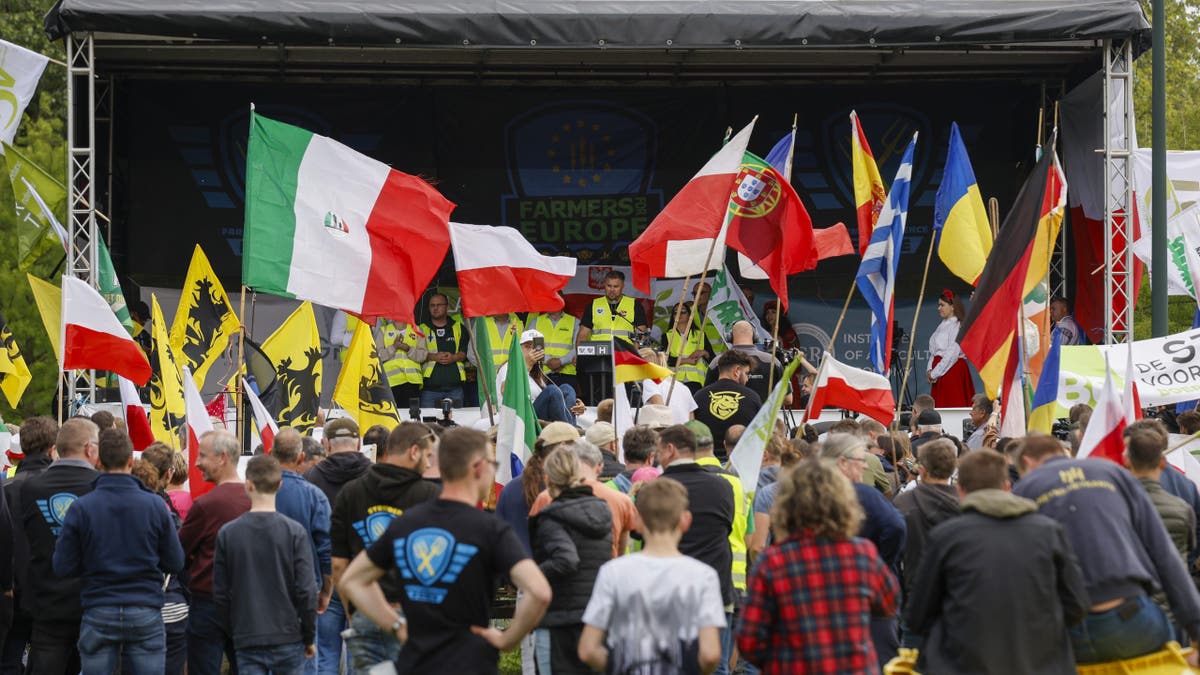
Farmers hold flags of European countries as they gather to listen to leaders’ speeches during a protest in Brussels, Tuesday, June 4, 2024. Farmers groups hope to sweep the Green Deal climate pact off the table. (AP Photo/Omar Havana) (AP Photo/Omar Havana)
The mainstream Conservatives got over two million more votes than the Reform Party but remain the second-largest political force in the country, prompting calls to reform the electoral system to give more representation based on the total votes.
Despite winning a historic number of seats in the U.K. Parliament, the Labour Party won the election with 9.6 million votes, down by over 600,000 votes, compared to its 2019 election results, when the party led under controversial socialist Jeremy Corbyn suffered two separate election defeats.
“In some cases, the Reform vote was probably mostly conservatives who had left the Conservative Party and decided to go there. But the far bigger component in Britain’s case was people who just decided not to vote at all,” Mendoza said. “The Conservative vote share went down 20 points, and a lot of conservatives who voted Conservative in 2019 just stayed at home and were not inspired by any of the parties.”

Labour Party leader Keir Starmer speaks to his supporters at the Tate Modern in London, Friday, July 5, 2024. (AP Photo/Kin Cheung)
In the 2019 election, the Conservatives, under the leadership of former Prime Minister Boris Johnson, won the majority of the parliament seats after campaigning on a populist platform of “Get Brexit Done.” The Reform Party’s predecessor, the Brexit Party, stood down its candidates in the election to boost the Conservatives.
In the aftermath of the elections, influential Conservative figures argued that the “Conservative family” consisting of the Reform Party and the Conservatives still beat Labour and won the majority of the votes – over 11 million – indicating the voters’ overall right-leaning bent.
Suella Braverman, a potential Conservative Party leadership contender, criticized the party’s performance in a speech at the Popular Conservatives conference and urged the party to embrace populism for the sake of the party’s future.
“To my mind, the Reform phenomenon was entirely predictable and avoidable and all our own fault,” she told the audience. “It’s no good denigrating Reform voters, it’s no good smearing the Reform party, it’s no good comparing Reform rallies to the rallies of Nuremberg. That’s not going to work. Criticizing people for voting Reform is a fundamental error to make.”
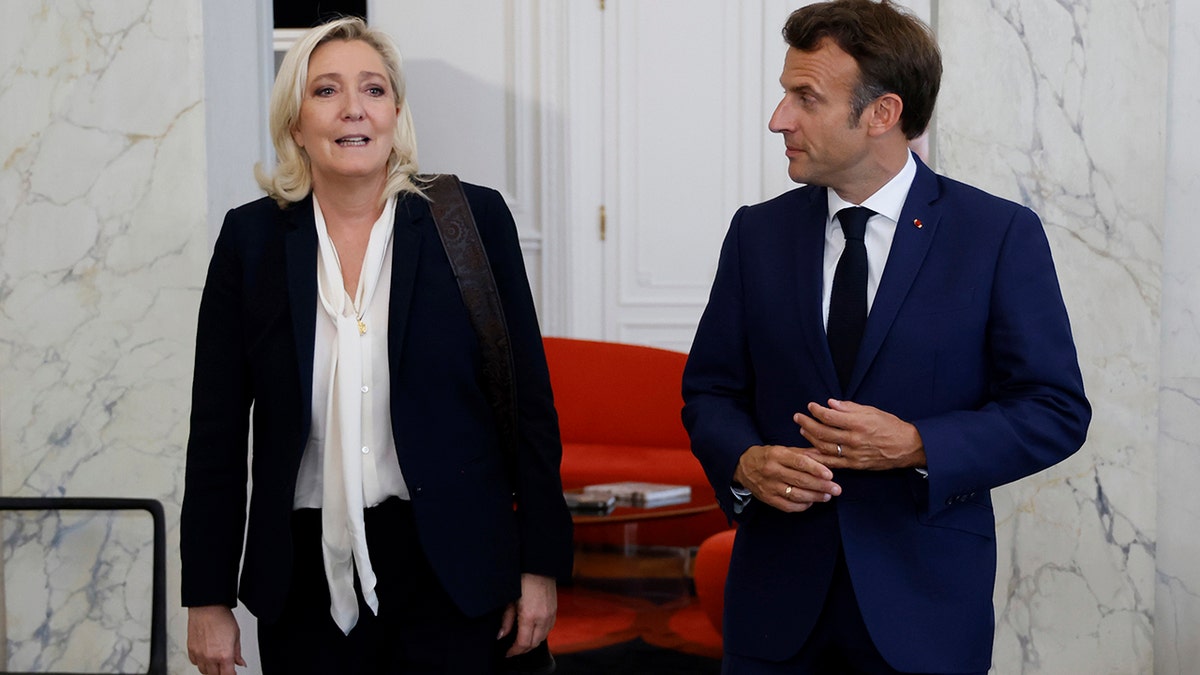
French President Emmanuel Macron, right, meets French far-right National Rally leader Marine Le Pen at the Élysée Palace on June 21, 2022, in Paris. (Ludovic Marin/Pool/AP)
She further urged the Conservatives to “restore credibility on the core conservative policies that unite” and address the immigration issue, “because we’ve been weak, we’ve been squeamish, we failed to tackle this very pressing concern.”
In France, although failing to gain legislative power, National Rally maintains populist momentum and is eyeing the 2027 presidential elections, with Le Pen primed to take control of the country’s highest office.
The new parliamentary majority of leftists and centrists, meanwhile, leaves Macron, already deeply unpopular, facing the prospect of presiding over a politically paralyzed hung parliament.
The Associated Press contributed to this report.

World
Caitlin Clark Not Gloating After WNBA All-Stars Top Olympic Team

PHOENIX – Caitlin Clark is not going to the Paris Olympics, and Saturday night at Footprint Center it sounded like she didn’t mind at all.
She’s been running at a hectic pace for a year, she said. First the regular college basketball season, then the NCAA Women’s Final Four, right into the WNBA draft, first half of the season and the WNBA All-Star Game. Every move analyzed, every shot dissected. Pardon her if she’d like to take the Olympic break off.
“See you in a month,” she said after the WNBA All-Stars took care of a U.S. Women’s Olympic team that didn’t select her in grand fashion, 117-109. “I’m going to do a few things for myself.”
She said she’s going on vacation and wouldn’t divulge the plans, although some of the time will be spent working out in the gym with her Indiana Fever teammates.
Any vindication she, fellow rookie Angel Reese and game MVP Arike Ogunbowale feel as they remain in the U.S. while Diana Taurasi and company head to Paris trying to win their eighth gold medal in a row was overshadowed by their respect for the players on the U.S. Olympic team.
“They have plenty of talent on that team,” Clark said. “If anything, it shows how good this league is, how much talent there is in this league. This was a good opportunity to help them prepare. I’ll be rooting for them. I mean, I love the Olympics. I’ve loved the Olympics since I was a little kid. They’re going to be just fine. They’re going to win gold and dominate.”
But there isn’t much time, and they have a lot of work to do, USA coach Cheryl Reeve acknowledged. Her team has one more exhibition game Tuesday in London against Germany, then it’s on to pool play at the Paris Olympics by the end of the week. “We weren’t good at what we were trying to do,” Reeve said.
Asked before the game if she had any second thoughts about not picking Clark, Reeve said: “From me? No.”
Clark dished out 10 assists, a rookie All-Star record and one shy of the record set by Sue Bird in 2017. She added a pair of layups but missed all seven of her 3-point attempts. Reese had 12 points and 11 rebounds, becoming the first rookie to post an All-Star double-double.. Ogunbowale set a WNBA All-Star record with 34 points, 21 alone during the third quarter.
Reeve admitted they all could have been on the Olympic team.
“We’ve said this for years: The depth of talent we have in the USA, no one has anything close to it,” she said. “There are players not on our team who are great players. Everyone knows that. There’s no suggestion that those players playing for the WNBA aren’t good enough to play for this national team. But only 12 can make it.”
There’s no question the WNBA has reached a watershed moment. Clark has had a major impact on attendance and television exposure both economically and artistically. After a brief period of indoctrination when the veterans bounced her around and hazed her, she’s earned their respect.
She’s 22 years old and it’s all upside for her and the league.
After 25 years of a 12-team format, the WNBA is expanding to San Francisco next season, Toronto soon after and to a 44-game schedule from 40. WNBA commissioner Cathy Engelbert promised 16 teams by 2028 during her pregame media conference.
The event was framed against Suns and Mercury owner Mat Ishbia opening a self-financed $100 million Mercury practice facility just south of the arena, putting them on par at least facility-wise with his NBA Suns.
The atmosphere was electric both inside and outside the arena Saturday night as a sellout crowd of 16,407 filled the building to the rafters.
“Walking through WNBA Live as I did yesterday and today, the buzz was unlike anything we’ve seen at All-Star Weekend,” Engelbert said. “We had a record 24 partners on hand to celebrate.”
The WNBA has ridden the Clark phenomenon to a new pending media rights deal, plus merchandizing and marketing beyond their wildest imaginations. This is no longer your grandma’s WNBA.
Engelbert cited the highest WNBA attendance overall in 26 years, 16 nationally televised games–14 featuring Clark –that have drawn a million viewers or more. WNBA app usage is up 530%.
“And we’re not even halfway through the season,” she said. “When I stood in front of you at this time last year, I knew we were poised for big things. We were preparing ourselves for big things, but I’m just so thrilled with what we’ve been able to accomplish over the last year.”
Of course, Clark, Reese and a new wave of WNBA players also came along.
“I’ve been so pleased with Caitlin and all of our rookies,” Engelbert said. “So many of this rookie class, they’re so strong, and they’re performing at the highest level. You guys are all writing about it, which we love. Yeah, I’m really pleased with how that’s working out.”
And why shouldn’t she be pleased? The Fever lead the league with an average attendance of 16,898, 15,306 on the road through 15 games.
And as Engelbert said, they’re only halfway through the season. After the Olympics it’ll be a mad rush to finish the second half and soar into the playoffs.
The first half has been a learning experience for Clark.
“I feel like from the start of the season to now it’s completely night and day for me,” she said. “I just feel so much more comfortable. Things are starting to slow down. I’m having more time to learn between games. The most exciting thing for me is I still have so much more room to grow.”
That may seem a little scary to the rest of the league. But now, Olympics be damned. It’s time for a little rest. And then back at it.
World
Ukraine and Russia fire dozens of drones at each other
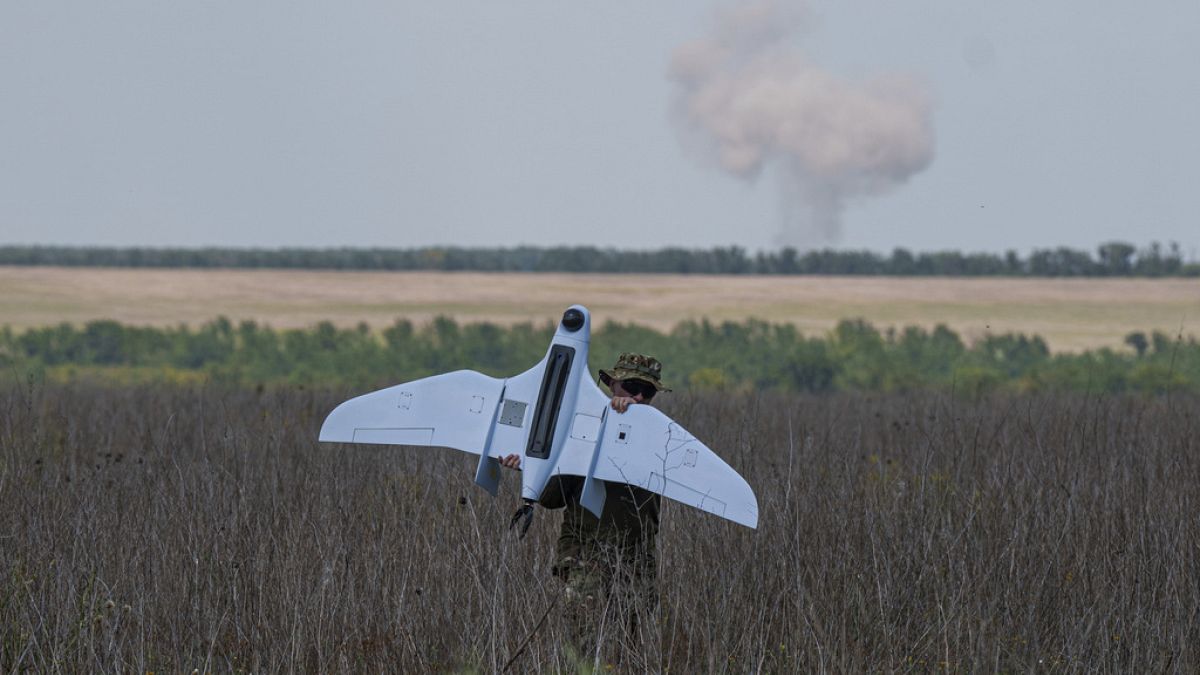
Ukraine said it downed 35 of 39 Russian drones overnight, whilst Russia said it shot down 26 Ukrainian drones over its southern Rostov region on Saturday.
Ukraine’ air force has reportedly shot down 35 of 39 Iranian made Shahed drones that Russia launched overnight on Sunday.
The air force also said Russia launched three Iskander-M ballistic missiles and two cruise missiles.
They claimed that the cruise missiles didn’t reach their targets due to Ukraine’s “countermeasures,” but didn’t mention what the Iskander-M missiles hit or whether any damage was caused.
No casualties have been reported.
Russian forces regularly attack civilian areas across Ukraine, but their attacks on Ukraine’s energy grid have intensified in recent months.
That’s resulted in often severe damage to multiple energy facilities and forced Ukraine to impose lengthy rolling blackouts.
Ukrainian authorities said that the Russian forces launched their attacks on three locations, including Russia’s Kursk Oblast, Primorsko-Akhtarsk – a town in Krasnodar Krai on the Azov Sea coast – and occupied Crimea.
Elsewhere in Ukraine, at least two people were killed and three more injured after a Russian missile strike on infrastructure in the country’s northeastern Kharkiv region, Governor Oleh Syniehubov said on Saturday.
Ukrainian officials also confirmed that the death toll following a Russian strike on Friday on the city of Mykolaiv near the Black Sea had risen to four. A child was among the victims, said the city’s mayor, Oleksandr Sienkevych.
Writing about the Mykolaiv strike on social media, Ukrainian leader Volodymyr Zelenskyy said that a projectile had hit a playground next to an apartment block.
“Russia proves every day with its terror that ‘pressure’ is not enough,” he said. “This destruction of life must be stopped. We need new solutions to support our defences. Russia must feel the power of the world.”
Russia’s attacks have left thousands of people without power or running water in the Poltava region of central Ukraine, Governor Filip Pronin said.
A pulverising Russian onslaught in recent months has forced Kyiv’s troops to withdraw from some towns and villages in the eastern Donetsk region.
Russia’s Defence Ministry also claimed on Saturday that it had shot down 26 Ukrainian drones over Russia’s southern Rostov region, several hundred kilometres from the front line.
Three more drones were destroyed over the Belgorod region, as well as one over the Smolensk region, it said. No casualties were reported.
World
The biggest of stories came to the small city of Butler. Here's how its newspaper met the moment
BUTLER, Pa. (AP) — When gunshots echoed at the Trump rally where she was working, Butler Eagle reporter Irina Bucur dropped to the ground just like everyone else. She was terrified.
She hardly froze, though.
Bucur tried to text her assignment editor, through spotty cell service, to tell him what was going on. She took mental notes of what the people in front and behind her were saying. She used her phone to take video of the scene. All before she felt safe standing up again.
When the world’s biggest story came to the small western Pennsylvania hamlet of Butler a week ago, it didn’t just draw media from everywhere else. Journalists at the Eagle, the community’s resource since 1870 and one that struggles to survive just like thousands of local newspapers across the country, had to make sense of chaos in their backyard — and the global scrutiny that followed.
Photographer Morgan Phillips, who stood on a riser in the middle of a field with Trump’s audience that Saturday evening, kept on her feet and kept working, documenting history. After Secret Service officers hustled the former president into a waiting car, the people around her turned to shout vitriol at the journalists.
A few days later, Phillips’ eyes welled with tears recounting the day.
“I just felt really hated,” said Phillips, who like Bucur is 25. “And I never expected that.”
Mobilizing in the most harrowing of situations
“I’m very proud of my newsroom,” said Donna Sybert, the Eagle’s managing editor.
Having put a coverage plan in place, she had escaped for a fishing trip nearby with her family. A colleague, Jamie Kelly, called to tell her something had gone terribly wrong and Sybert rushed back to the newsroom, helping to update the Eagle’s website until 2 a.m. Sunday.
Bucur’s assignment had been to talk to community members attending the rally, along with those who set up a lemonade stand on the hot day and people who parked cars. She’d done her reporting and settled in to text updates of what Trump was saying for the website.
The shooting changed everything. Bucur tried to interview as many people as she could. Slightly dazed after authorities cleared the grounds, she forgot where she had parked. That gave her more time for reporting.
“Going into reporter mode allowed me to distract myself from the situation a little bit,” Bucur said. “Once I got up, I wasn’t thinking at all. I was just thinking I needed to interview people and get the story out because I was on deadline.”
What to know about the 2024 Election
- Read the latest: Follow AP’s live coverage of this year’s election.
- Democracy: American democracy has overcome big stress tests since 2020. More challenges lie ahead in 2024.
- AP’s Role: The Associated Press is the most trusted source of information on election night, with a history of accuracy dating to 1848. Learn more.
- Stay informed. Keep your pulse on the news with breaking news email alerts. Sign up here.
She and colleagues Steve Ferris and Paula Grubbs were asked to collect their reporting and impressions for a story in the Eagle’s special, eight-page wraparound printed edition on Monday.
“The first few gunshots rang out like fireworks,” they wrote. “But when they continued, people in the crowd at the Butler Farm Show venue dropped to the ground: a mother and father told their children to crouch down. A young man hunched over in the grass. Behind him, a woman started to pray.”
The special edition clearly resonated in Butler and beyond. Extra copies are being offered for sale for $5 in the Eagle’s lobby. That’s already a bargain. On eBay, Sybert said, she’s seen them going for up to $125.
A small newspaper struggling to endure
Beyond its status as a local newspaper, the Eagle is an endangered species.
It has resisted ownership by a large chain, which have often stripped news outlets bare. The Eagle has been owned by the same family since 1903; its patriarch, Vernon Wise, is now 95. Fifth-generation family member Jamie Wise Lanier drove up from Cincinnati this week to congratulate the staff on a job well done, general manager Tammy Schuey said.
Six editions are printed each week, and a digital site has a paywall that was lowered for some of the shooting stories. The Eagle’s circulation is 18,000, Schuey said, with about 3,000 of that digital.
The United States has lost one-third of its newspapers since 2005 as the Internet chews away at once-robust advertising revenue. An average of 2.5 newspapers closed each week in 2023, according to a study by Northwestern University. The majority were in small communities like Butler.
The Eagle abandoned a newsroom across town in 2019, consolidating space in the building where its printing press is housed. It has diversified, starting a billboard company and taking on extra printing jobs. It even stores the remnants of a long-shuttered local circus and allows residents to visit.
The Eagle has about 30 employees, although it’s now short two reporters and a photographer. Cabinets housing old photographs lie among the clutter of desks in the newsroom, with a whiteboard that lists which staff members will be on weekend call.
Its staff is a mix of young people like Bucur and Phillips, who tend to move on to larger institutions, and those who put down roots in Butler. Sybert has worked at the Eagle since 1982. Schuey was initially hired in 1991 to teach composing room employees how to use Macs.
“This is a challenging business,” Schuey said. “We’re not out of the woods yet.”
Local understanding makes a huge difference
When a big story comes to town, with the national and international journalists that follow it, local news outlets are still a precious and valued resource.
The Eagle knows the terrain. It knows the local officials. Smart national reporters who “parachute” into a small community that suddenly makes news know to seek out local journalists. Several have reached out to the Eagle, Schuey said.
Familiarity helps in other ways. Bucur found people at the rally who were suspicious of national reporters but answered questions from her, and the same is true for some authorities. She has tapped her network of Facebook friends for reporting help.
Such foundational trust is common. Many people in small towns have more faith in their community newspapers, said Rick Edmonds, the media business analyst at the Poynter Institute.
“It’s just nice to support the locals,” said Jeff Ruhaak, a trucking company supervisor who paused during a meal at the Monroe Hotel to discuss the Eagle’s coverage. “I think they did a pretty good job covering it for their size.”
The Eagle has another advantage as well: It isn’t going anywhere when the national reporters leave. The story won’t end. Hurt people need to recover and investigations will determine who is responsible for a would-be assassin being able to get a shot at Trump.
In short: responsible journalism as civic leadership in harrowing moments.
“Our community went through a traumatic experience,” Schuey said. “I was there. We have some healing to do, and I think the newspaper is a critical piece in helping guide the community through this.”
So, too, must people at the Eagle heal, as Phillips’ raw emotions attest. Management is trying to give staff members some days off, perhaps with the help of journalists in surrounding communities.
Bucur said she would hate to see Butler turned into a political prop, with the assassination being used as some sort of rallying cry. The divisiveness of national politics had already seeped into local meetings and staff members have felt the tension.
Sybert and Schuey look at each other to try and remember what was the biggest story that Butler Eagle journalists have worked on. Was it a tornado that killed nine back in the 1980s? Some particularly bad traffic accident? Trump paid an uneventful campaign visit in 2020. But there’s no question what tops the list now.
Despite the stress of the assassination attempt, covering it has been a personal revelation for the soft-spoken Bucur, who grew up 30 miles (48.2 kilometers) south in Pittsburgh and studied psychology in college. Her plans changed when she took a communications course and loved it.
“This,” she said, “was a moment I told myself that I think I’m cut out for journalism.”
___
David Bauder writes about media for the AP. Follow him at http://twitter.com/dbauder.
-

 News1 week ago
News1 week agoVideo: Biden ‘Is a Fighter,’ Harris Says in North Carolina
-

 Politics1 week ago
Politics1 week agoTwo key states to see massive GOP voter registration operation
-

 Movie Reviews1 week ago
Movie Reviews1 week agoFilm Review: Fly Me to the Moon – SLUG Magazine
-
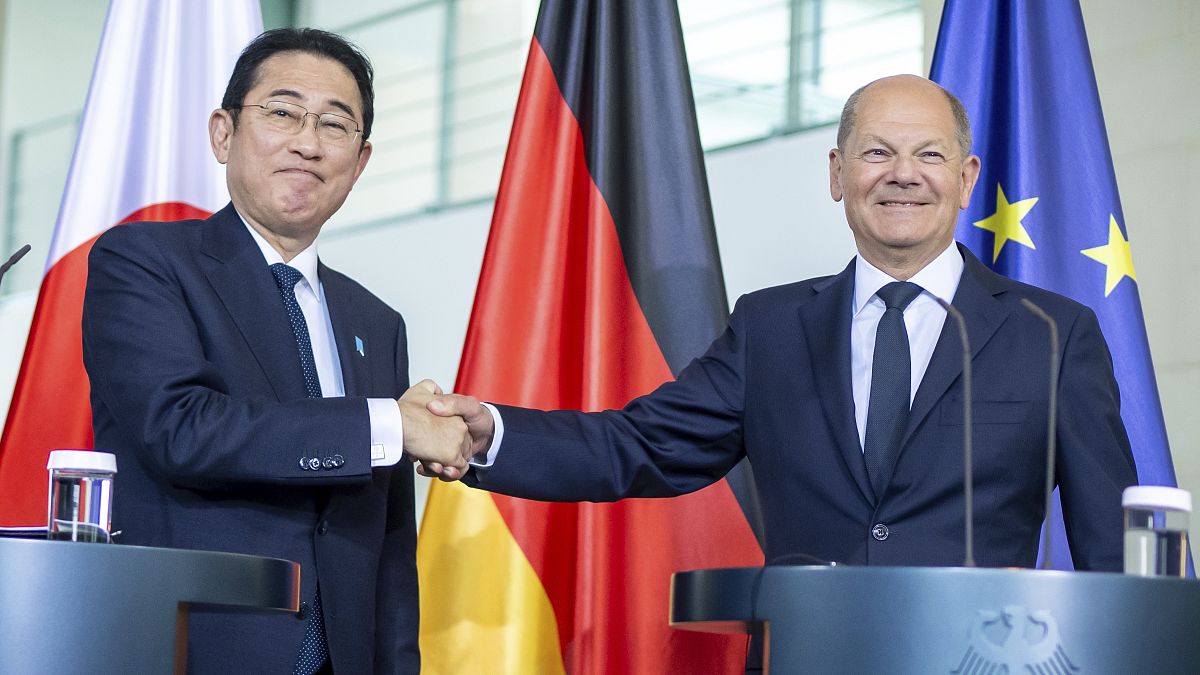
 World1 week ago
World1 week agoJapan, Germany agree to boost security cooperation in Pacific
-
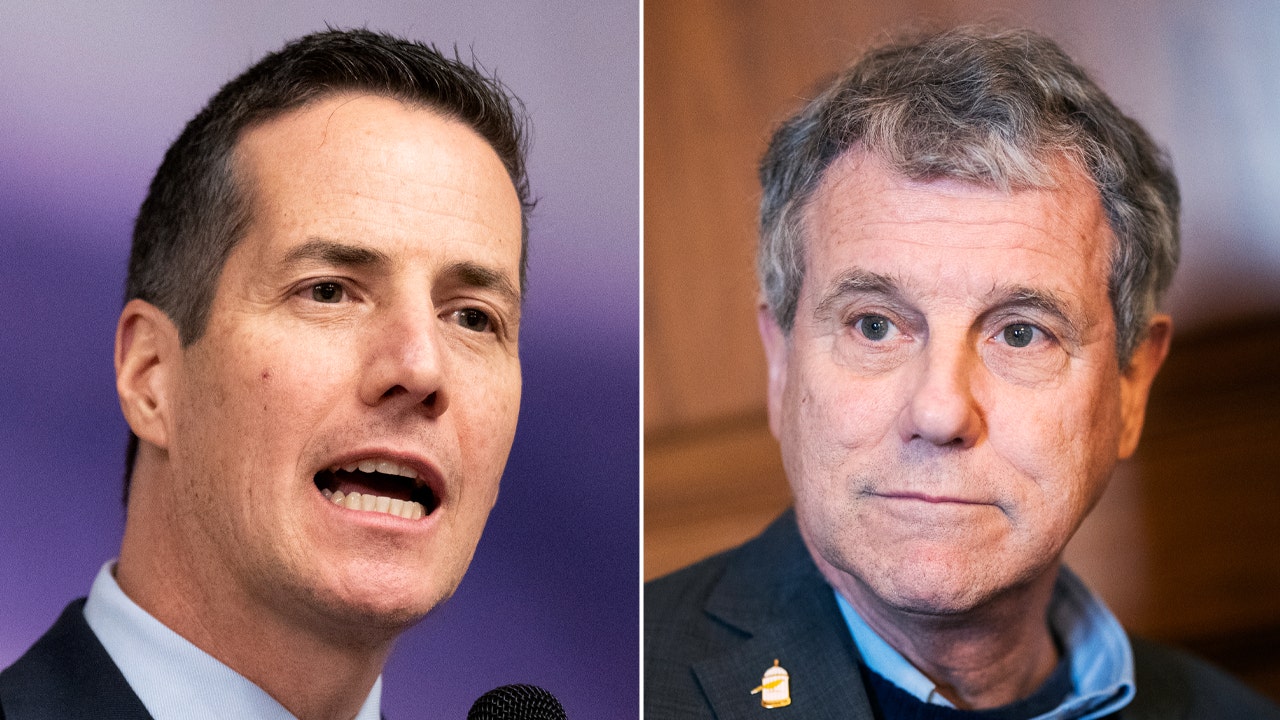
 Politics1 week ago
Politics1 week agoGOP challenger calls on Ohio Dem Sherrod Brown to 'fess up' with what he knew about Biden's condition
-

 World1 week ago
World1 week agoKenya’s Ruto dismisses almost entire cabinet after nationwide protests
-
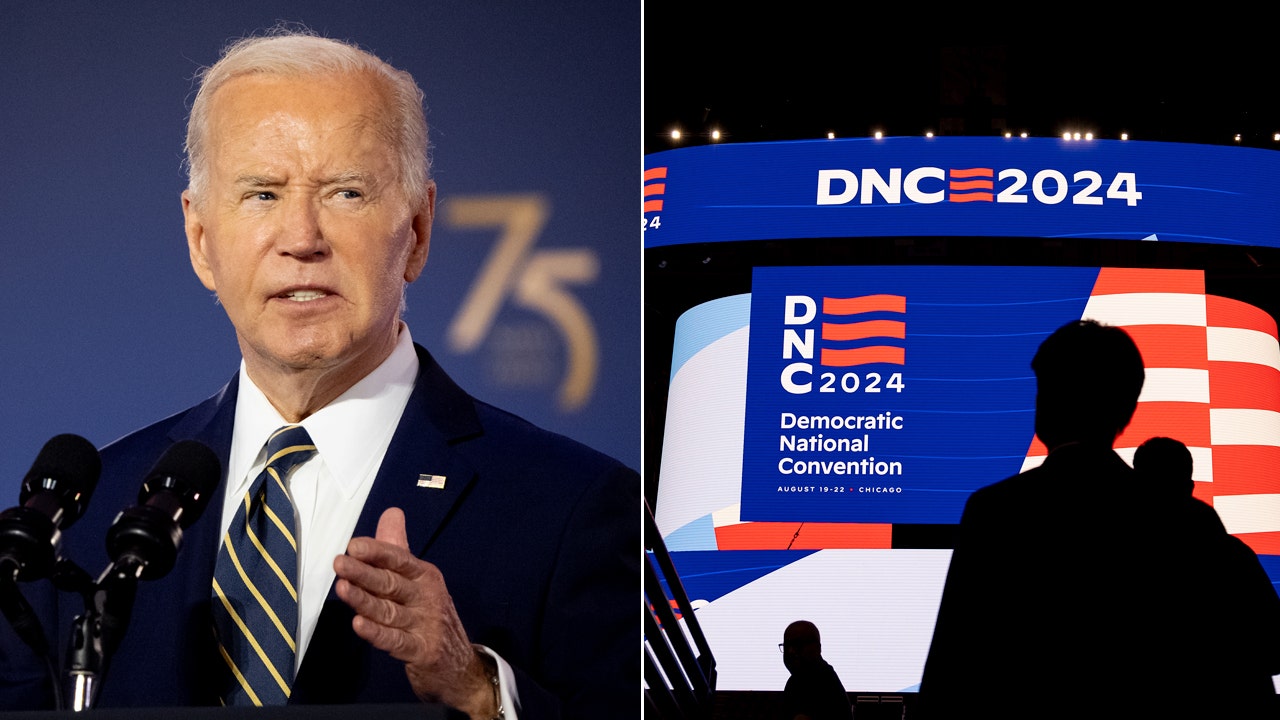
 Politics1 week ago
Politics1 week agoIs it too late for DNC delegates to abandon Biden? A look at the Democrats' nomination process
-

 Politics1 week ago
Politics1 week agoBiden says 'anyway' at least 9 times while trailing off in press conference











